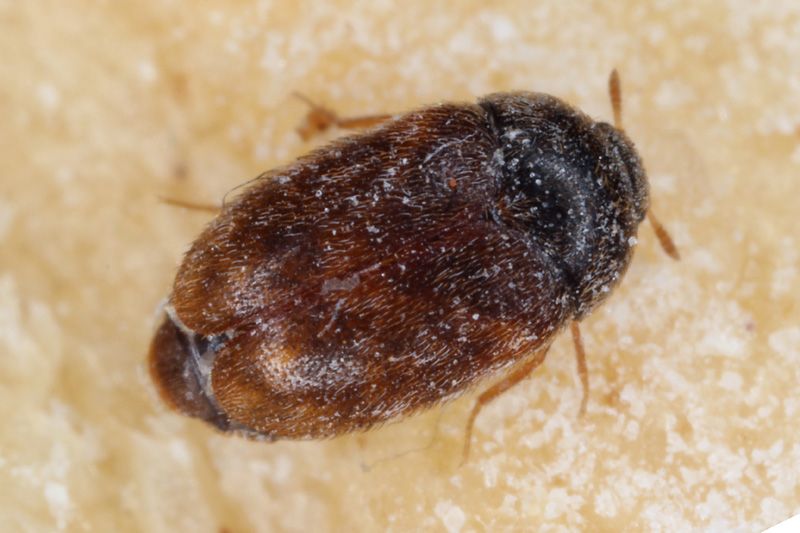
Khapra Beetle – Trogoderma granarium
Khapra Beetle – Trogoderma granarium
Description of Insect:
The Khapra beetle (Trogoderma granarium) is an invasive insect that primarily targets stored grain and other food products. This small, reddish-brown beetle is known for its exceptional ability to infest a variety of dry food materials, hence also called “cabinet beetle.” Adult Khapra beetles are approximately 1.6-3 mm in length and are characterized by their narrow, elongated bodies, covered with hairs. The beetles have a distinctive appearance, with a rough, mottled texture on their thorax.
The larvae of the Khapra beetle are typically pale, yellowish-white, and elongated, with a small head and several distinct segments. They have brown head and body hairs, and grow up to 1.8 mm long. These larvae are the primary damaging stage of the insect, as they feed on stored grains and other dry foodstuffs.
The Khapra beetle’s ability to thrive in dry, warm environments and its resistance to many common insecticides make it particularly difficult to control. Because of these characteristics, the Khapra beetle is classified as one of the 100 worst invasive species of the world.
Life cycle of Khapra Beetle:
The Khapra beetle has a complex life cycle consisting of four stages: egg, larva, pupa, and adult. The life cycle is highly adaptable, allowing the beetles to survive in a range of environmental conditions, from arid regions to more temperate climates.
Females lay 50-100 eggs which are typically laid in small clusters, often within or on food products. The eggs take about 5 to 7 days to hatch. Once hatched, the larvae enter the feeding stage, where they begin to consume the food around them. This stage is the most destructive phase of the beetle’s life cycle. This is because the larvae are capable of infesting a wide variety of stored products, including grains, dried fruits, spices, and even seeds.
During their larval stage, which can last anywhere from a few weeks to several years, the larvae will feed, grow, and molt several times. They eventually mature into pupae, at which point they cease feeding and enter a resting state. The adult beetles emerge from the pupae, and begin to search for food sources and mates, repeating the life cycle. Even though the adults have wings, they do not fly and die within a few days.
The Khapra beetle’s life cycle is particularly notable for its flexibility. In ideal conditions, the life cycle can be completed in just 26 days, allowing for up to 10 generations per year. However, the beetle can also survive for extended periods in harsher conditions by entering a state of dormancy. In these states, the beetles can endure prolonged periods without food, making them exceptionally resilient in storage environments.
Damage they cause:
Unlike many other pests that attack fresh crops, the Khapra beetle specifically targets grains, seeds, and other dry foodstuffs. This poses a significant threat to food security worldwide, particularly in regions that rely on grain storage for long-term food supplies.
- Destruction of Stored Products: The larvae of the Khapra beetle are the primary agents of damage, feeding on a variety of stored commodities. It also leaves behind cast larval skin, which contaminates the food and makes it unfit for consumption. This damage makes the affected food unappetizing, often leading to entire shipments being discarded.
- Economic Impact: In regions where grain and dried food products are essential exports, infestations can lead to significant losses. The contamination can also affect international trade, as countries often impose strict quarantine regulations to prevent the spread of this invasive pest. In addition, infested products also require an expensive control and eradication program to manage the situation. As a result, agricultural exports can be delayed or banned, affecting the livelihoods of farmers and traders.
- Food Contamination: The beetles can also carry fungi on their bodies, leading to the contamination of food. This can result in the spread of pathogens that may cause foodborne illnesses in humans or animals, such as gastrointestinal distress and skin irritation. The presence of this pest in stored food supplies could have serious public health implications.
